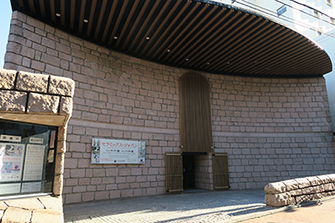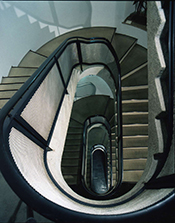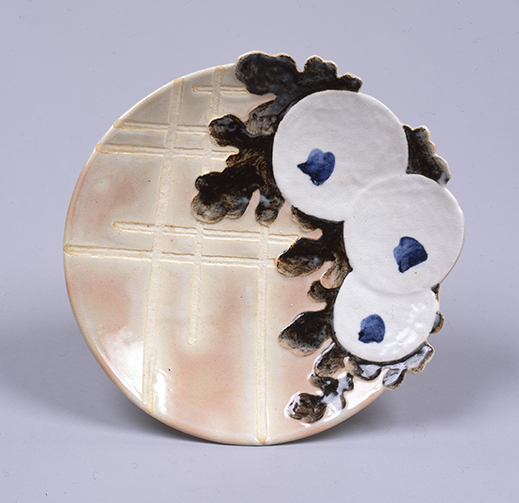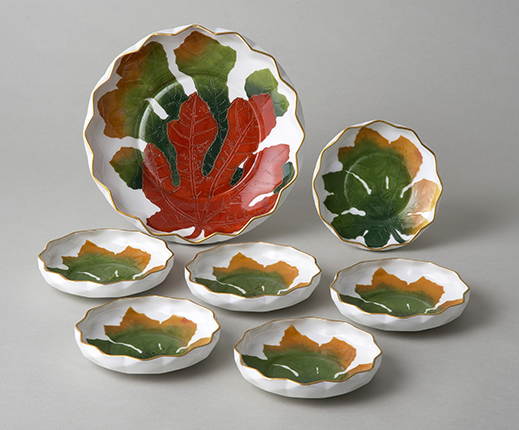 |
Focus features two in-depth reviews each month of fine art, architecture and design exhibitions and events at art museums, galleries and alternative spaces around Japan. The contributors are non-Japanese art critics living in Japan. |
|
|
 |
 |
 |
Design by Design in Modern Japanese Ceramics: The Shoto Museum of Art
Alice Gordenker |
 |
Picture plate in the "new Majolica style" (1905) by Hazan Itaya (1872-1963). Collection of Tokyo Tech Museum and Archives. |
Ceramics of Japan's modern era -- the span of roughly 70 years between the Meiji Restoration of 1868 and the end of the Second World War -- has emerged as something of a hot topic within Japan. This is seen in a run of recent exhibitions of ceramics from this period, which began when the country ended hundreds of years of seclusion and embarked on a program of rapid modernization. But the shows to date have tended to be narrow in scope, limited to the ornate ceramics created for export, for example, or focusing on a single artist. What has been lacking is a broader overview.
That gap is now ably addressed by Ceramics Japan: Tracing Japanese Modern through Ceramics, a travelling exhibition curated by Hitoshi Mori, director of the Yanagi Sori Design Memorial at Kanazawa College of Art, with contributions from other noted scholars from around the country. After stops in Gifu, Ishikawa, and Hyogo prefectures, the exhibition is now in its final showing, through 29 January, at the Shoto Museum of Art in Tokyo. Ceramics Japan is the first exhibition to provide a comprehensive review of ceramics made in modern-era Japan, and offers a special focus on design.
 |
|
 |
|
The Shoto Museum of Art is in central Tokyo, not far from Shibuya station. |
The Shoto is a public museum, established in 1981 by Tokyo's Shibuya ward, and is situated in a quiet residential area about 15 minutes on foot from Shibuya station. Designed by architect Seiichi Shirai (1905-83), the building is meant to evoke the intimacy and elegance of a fine private home. Display space on each floor is limited, so the exhibition begins in the basement level and continues upstairs on the second floor. There is an elevator, should you need it, but most visitors take the opportunity to climb the spiral staircase that is one of the museum's hallmarks.
Lidded pots with mythical shishi lions, decorated in Tokyo in Satsuma style by Tomezo Niimura with gold and overglaze enamels. Early Meiji period/late 19th century. Private collection. |
The exhibition is divided into four sections, opening with the period immediately after the Meiji Restoration, when Japan's political system was modernized along Western models. An interesting thread running through the show, if you look for it, is the significant role played by the Japanese government in guiding and shaping modern ceramic design. For example, as part of its economic policy, the new Meiji government aggressively pursued entry into international markets, offering a wide range of decorative arts, including ceramics, at the international exhibition in Vienna in 1873. This effort proved a huge success and set off a fad in Europe and the United States for all things Japanese. The government immediately created a public trading company (the Kiryu Kosho Gaisha) for exports, and spurred the Japanese ceramics industry into new activity with calls for novel products and designs. New workshops sprang up in Tokyo, Yokohama and Nagoya, close to the ports, specializing in the painting of designs with export appeal onto undecorated pieces brought in from traditional ceramic-making areas, including Satsuma, Seto and Arita.
 |
|
Plate with chrysanthemum design in Art Nouveau style (1907), designed by Chu Asai (1856-1907) and manufactured by Rokubei Kiyomizu IV (1848-1920). Collection of Kyoto Institute of Technology Museum and Archives. (AN.5461) |
By the early 1880s the Japonism boom had faded. Japan's ceramics industry needed new strategies to maintain exports, which were now critical to its survival. Ceramics schools and research centers were set up around the country, often with government support, to improve manufacturing techniques and promote a more aesthetic approach to product design. Although many companies chose the easy route of following international trends and pandering to exoticism, in every production area there were those who sought to break through with original designs or proprietary technology. Artists in other media, including the Western-style painter Chu Asai, collaborated with ceramic makers to develop new designs, often drawing inspiration from international movements such as Art Nouveau and Art Deco.
|
 |
|
|
|
Lamp stand with rabbits (1927) made by the Government Research Institute for Ceramics, a prototype of which was exhibited at the Philadelphia World's Fair in 1926. Collection of the Industrial Research Center of Shiga Prefecture.
|
In the 1920s, as Japan gained standing in the world as a modern state, there was an increasing feeling that the nation's ceramics industry should look less to other countries for inspiration and develop its own style. This was also true in other fields of expression, as demand grew throughout the world for more individualistic design. At the same time, Japanese consumers were consciously pursuing different lifestyles to suit modern times, and demanded a new aesthetic even in ceramics for daily use. During this period, the Government Research Institute for Ceramics worked successfully on the development of tasteful Japanese-style designs for Western-style dishes. They also expanded the market by developing ceramics for building use, including interior and exterior tiles, outdoor lighting fixtures, and ornaments for fountains and facades.
 |
|
Shaped dishes designed by Atsushi Hino and manufactured by Okura Toen in 1925 (large plate) and 1929 (smaller plates), using a traditional maki-e etching technique. Private collection.
|
Once war came, it was impossible for ceramics companies to conduct business as usual; all their work was redirected into the war effort. Even designers were tasked with developing ceramic substitutes for metal goods, which had become scarce due to the war, or creating patriotic works as tributes to the glory of the nation. Interesting items from the war years include a ceramic hot-water bedwarmer (to replace the usual tin model), a ceramic stove for burning coal, and even a ceramic hand grenade. Designers may not have been able to choose what they worked on, but many continued to do good work -- as handsomely demonstrated by a pair of 1942 ashtrays at the end of the exhibition. Sleek and stylish, it's hard to believe they were designed in the middle of a war, and in a government research center at that.
As a general survey, Ceramics Japan provides both a solid overview of a modernizing industry and welcome context for the exhibitions on specific styles and artists that preceded it. The catalog, which covers new ground, contains only limited English but will nevertheless be of interest to international collectors and scholars for its many images, rare photographs, and pottery marks.
All images courtesy of the Shoto Museum of Art.
There will be an English-language guided tour of this exhibition on Friday, 20 January 2017 at 6:30 p.m.
No reservations required; free with regular museum admission. |
 |
| Ceramics Japan: Tracing Japanese Modern through Ceramics |
| 13 December 2016 - 29 January 2017 |
| The Shoto Museum of Art |
Phone: 03-3465-9421
Open 10 a.m. to 6 p.m., Fridays until 8 p.m. (last entry 30 minutes before closing)
Closed Mondays, or the following Tuesday when Monday is a national holiday
Access: 5-minute walk from Shinsen Station on the Keio Inokashira Line or a 15-minute walk from Shibuya Station on the JR and Tokyo Metro Lines |
|
 |
 |
Alice Gordenker
Alice Gordenker is a writer and translator based in Tokyo, where she has lived for more than 17 years. For over a decade, she penned the "So, What the Heck Is That?" column for The Japan Times, providing in-depth reports on everything from industrial safety to traditional talismans. She translates and consults for museums, and has a special interest in making Japanese museums more accessible for visitors from other countries. |
|
 |
|